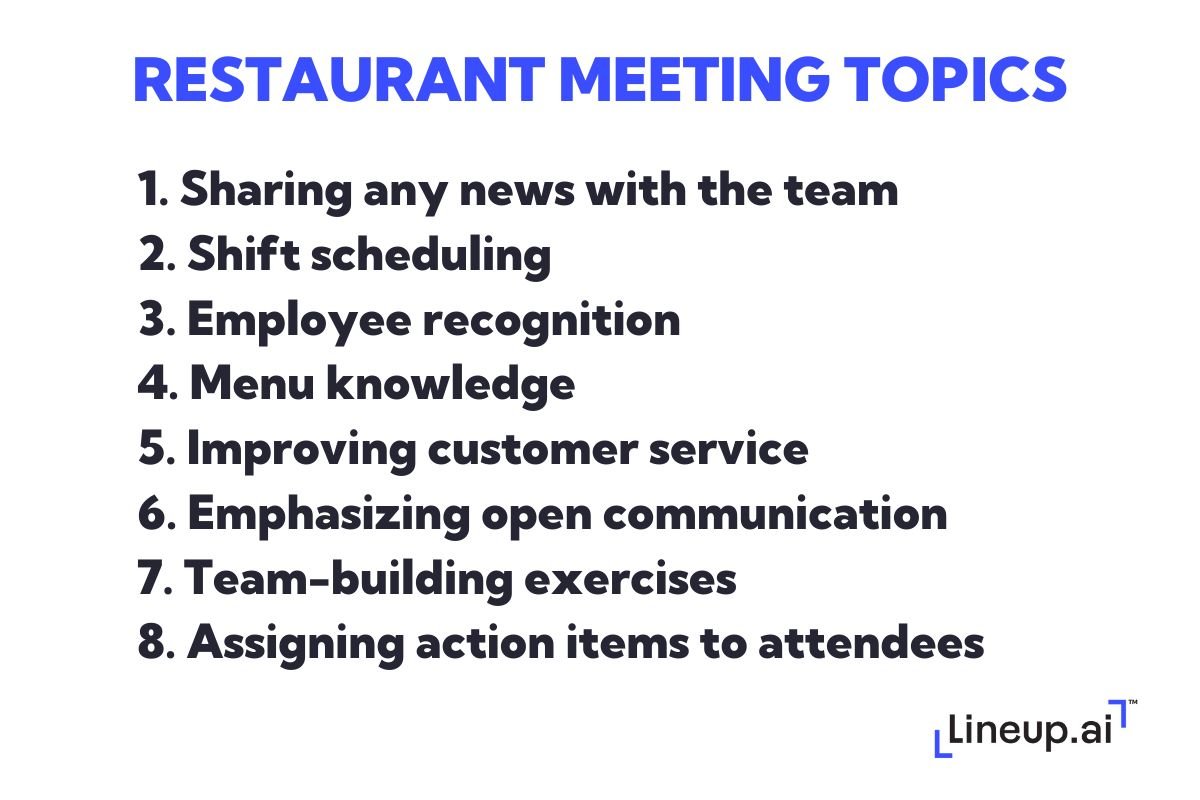Fewer surprises. Greater restaurant efficiency.
Fewer surprises. Greater restaurant efficiency.
Staff meetings aren't always the most popular thing in the restaurant world. Still, sometimes you need to get the whole team in a room and on the same page - both kitchen and front-of-house staff. In order to make sure your restaurant meetings are as efficient and positive as possible, follow these helpful tips.
1. Invite the right people
Make sure only to invite the people who absolutely need to attend the meeting. For example, there’s no reason for your entire front-of-house and back-of-house staff to attend a meeting that only concerns the management team.
Don’t waste staff members’ time by having them sit through meetings that aren’t relevant to them.
Remember — inviting people who don’t need to be there costs the business money and ultimately affects your restaurant’s profitability. Additionally, unnecessary meetings are an added burden to your staff’s workload, and can contribute to burnout.
On the other hand, failing to invite all the right people can disrupt the flow of the meeting and result in unresolved issues. This will ultimately lead to you having to schedule yet another meeting to get input from those that weren’t present in the first meeting.

2. Prepare an agenda
To ensure your team meeting ends up being effective, prepare a clear agenda beforehand.
Set a goal for what you’d like to get out of the meeting, and write down talking points and topics you’d like to discuss.
It’s also a good idea to involve your team in creating the agenda. Ask staff members if there are specific topics or issues they’d like to discuss during the meeting, and then add those as agenda items.
Send the meeting agenda to your team at least 24 hours in advance to make sure everyone knows what’s going to be discussed in the meeting.
3. Keep it short
Work expands to fill the time allocated to it. The same is true for meetings. If you schedule a meeting to last 30 minutes even though you realistically only need 15, you’ll find a way to fill up those remaining 15 minutes.
To prevent this from happening, set the meeting length to the minimum amount of time you think you’re going to need to go over the meeting agenda. For most meetings, this is going to be between 15 to 30 minutes.
At the start of the meeting, walk your staff through the meeting agenda and let them know how much of the meeting time you want to spend on each topic. Here’s what restaurant meeting topics might look like:
- News – Welcoming new staff members and sharing other important news.
- Shift scheduling – Discussion of shift schedules, coverage issues, and time-off requests.
- Employee recognition – Praising accomplishments of the team and of individual staff members.
- Menu knowledge – Familiarization with new menu items, revisiting existing ones, understanding ingredients for allergy-related queries, and knowing the preparation methods for effective customer communication.
- Customer service – Review of customer feedback, suggestions for improving service, handling difficult customers, and sharing best practices for customer experience in a restaurant.
- Communication – Emphasizing open restaurant staff communication, discussing concerns or issues faced by staff, and brainstorming solutions.
- Team Building – Time for team-building exercises, bonding activities, or simply sharing personal news to build stronger relationships amongst the team.
- Action items – Assigning action items to attendees.
- Wrap up – Giving staff members a few minutes to ask questions or provide comments.

4. Engage your staff
Make sure to leave some time for staff members to ask questions or add comments. This is a good opportunity to identify any frustrations or knowledge gaps your team might have.
Note that staff members can be reluctant to actively participate in meetings due to a number of reasons, including fear of saying the wrong thing and being judged or ridiculed.
You need to make staff members feel comfortable to express their thoughts and opinions.
Additionally, you’ll often find that discussions will be dominated by one or two of your more vocal team members. Make sure to engage other staff members as well by asking for their opinion directly.
Finally, it’s important to act on staff members’ suggestions — if none of their ideas ever get implemented, they’re unlikely to want to continue contributing new ones.
5. Celebrate achievements
Your staff meeting is a good place to celebrate your staff’s achievements, both those of individual team members as well as the team as a whole.
When offering praise, it’s important to be genuine and do it only when it’s deserved.
Additionally, find a way to praise all your employees. If you only praise a few of your staff members all the time, the others are likely to develop resentment.
You do need to be mindful of how specific staff members prefer receiving praise. Some might enjoy public recognition for their work, while others might be more comfortable receiving praise in private.
6. Ask for feedback
This practice is vital as it provides an avenue for open dialogue, allowing employees to voice their opinions, ideas, and concerns. Staff often have unique insights into customer behavior, operational issues, and potential improvements, given their direct interaction with clients and day-to-day operations.
To solicit feedback, create a safe and open environment where everyone feels comfortable speaking up. You can use open-ended questions to prompt discussion or provide anonymous methods for submitting feedback. By valuing and acting upon the feedback received, you not only improve restaurant operations but also boost staff morale, demonstrating their importance to the business.
7. Take notes
Taking notes during a meeting gives you a way to document decisions and helps you keep track of all the important points brought up throughout the meeting. You can take notes yourself or assign a staff member to do it.
When taking notes, it’s important not to try to capture every word. Instead, write down only the most important information.
This will ensure you’re able to focus on the discussion itself, rather than spending all your time writing things down.
To make it easier to take notes, do some prep work before the meeting by creating an outline or template for your notes. It might include information such as:
- Meeting date, start time, and end time
- Meeting purpose and goal
- Attendees
- Questions that need to be answered
- Deadlines
Finally, make sure to share the notes with staff members who weren’t able to attend the meeting to make sure they’re kept up-to-date on all decisions made during the meeting.
8. Conclude with action items
Any meeting that ends with no action items is likely a waste of your staff’s time.
Staff members should leave the meeting knowing what’s expected of them. This is why you should conclude the meeting by assigning everyone action items.
These represent the next steps that need to be taken in order to move towards accomplishing a specific goal that was defined during the meeting.
Action items help to hold staff members accountable and are useful for tracking progress toward achieving goals.
Every action item needs a clear assignee so it doesn’t get left behind. You should also make sure each person has everything they need to complete their assigned tasks.
Improve your staff meetings with our top tips
Ready to make your restaurant staff meetings a lot more effective? Follow the tips we outlined above for your next meeting and see for yourself what a difference it will make.
Further read:

Boris Mustapic is a content marketer with a decade of experience in the digital marketing industry. He specializes in helping B2B SaaS companies drive growth through strategic, product-led content marketing.
More about the author